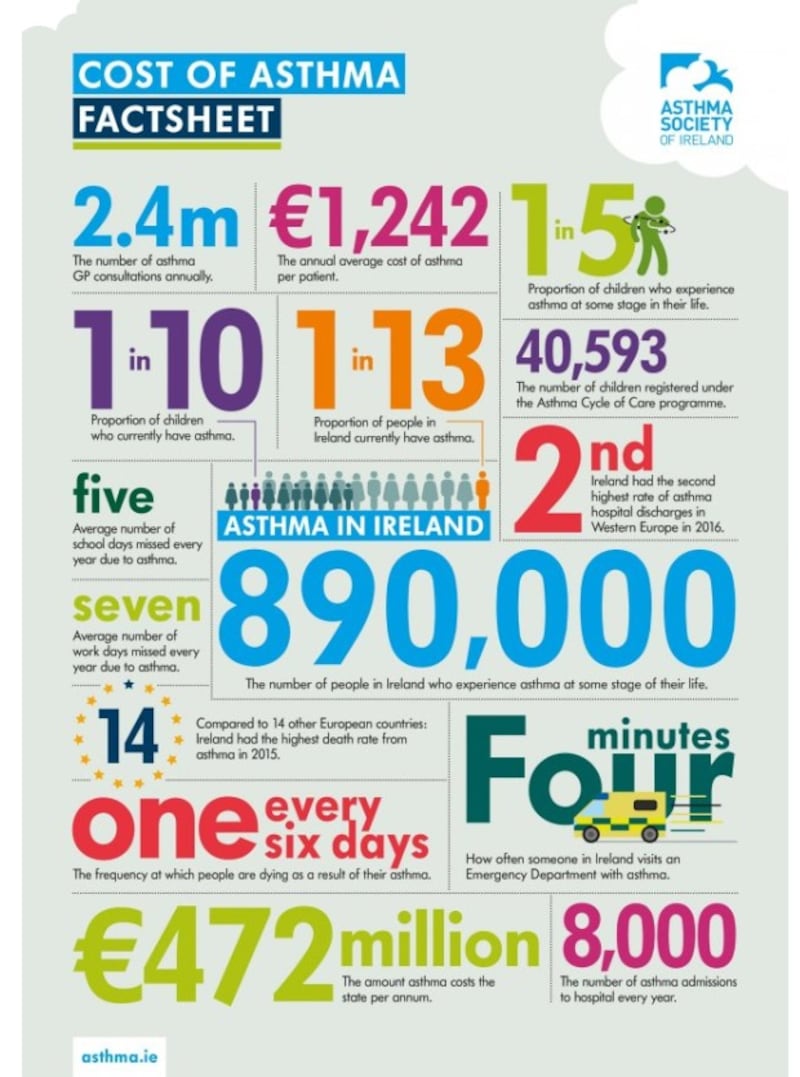September has been mild, and the fires haven’t been lit yet. When the temperature drops, as it will surely do at some stage, my lungs will know straight away. I am one of the roughly 8 per cent of the population that suffers from asthma, a debilitating, frightening condition that is responsible for 8,000 hospital admissions every year. Like the poor canaries sent into the coal mine, the onset of wheezing and coughing signals that the air I’m breathing is polluted, whether from traffic or particulate matter from solid fuels or both together. I’m one of the lucky ones for whom medication works well, and I have never been hospitalised with the condition (though I do clock up additional GP visits).
But for many people, asthma is a life-limiting and potentially fatal condition. One person a week dies from it. One in ten children suffer from it, with an average of five school days missed for every child each year. If you’re not shocked by those statistics, try this one: as recently as 2015, Ireland had the highest death rate from asthma of fourteen European countries.

The EPA estimates that there are 1,300 premature deaths due to poor air quality in Ireland every year. These deaths are not necessarily all due to respiratory failure, though people with asthma are at high risk. According to the EPA’s air quality website, the poisonous havoc wreaked by tiny air pollution particles can start in the womb, where air pollution is linked with lower birth weights of babies. In toddlers, development problems are increased due to air pollution with increased rates of wheezing and coughing. Slower development of lung function is observed in children, whilst in adults a wide range of symptoms including heart attacks, lung function decline, Type 2 diabetes, asthma and lung cancers are now all linked to air pollution. For the elderly, exposure to poor air quality increases the probability of dementia, strokes and heart failure.
Research that I reviewed for a project led by DCU and Community Law and Mediation in 2021-2 found that vulnerable groups such as the elderly, children, and those of lower socioeconomic status are more affected by environmental hazards, as are those living in urban areas. One of the Irish studies we found linked increased hospital admissions for respiratory and cardiovascular conditions with exposure to air pollution in disadvantaged areas of Dublin city. A more recent study found that hospital admissions for asthma also fell noticeably as air quality improved during Covid-19 lockdowns.
READ MORE
[ Managing asthma: ‘I never felt like my symptoms could ever improve’Opens in new window ]
[ ‘Asthma does not stop me from achieving anything I set my mind to’Opens in new window ]
There is scant written about the impacts on children of poor air quality in socially deprived urban areas, and the kind of interventions needed to improve air quality and health outcomes in inner-city neighbourhoods. Yet children are more vulnerable to the effects of long-term exposure to air pollution than adults. Poor air quality is sending people into hospital every day, yet there has only been one breach of EU air quality limits since 2010. This shows how dangerous even legally permissible levels of air pollution can be.

Children are regularly exposed to traffic-related air pollution concentrations near schools, due to the health and environmental scourge of engine idling. To their credit, over 150 schools participated in a 2022 ‘citizen science’ project to capture air quality data, finding polluted sites (rated ‘medium’ to ‘high’) in Dublin and other urban centres. Has this information led to public awareness campaigns like the recent one by Idling Action London? Changes in driver behaviours? Air quality alerts? Perhaps parents and boards of management have rallied to ban parking and engine idling at school gates, and campaigned for school streets to enable children to walk and cycle to the school gate. But I’m just not seeing it. Vocal opponents of any vehicular restrictions get more airtime and more representation. What is the use in training the next generation to understand the science if they cannot use it to effect change?
Air pollution comes from burning solid fuels like coal, peat and wet wood, as well as traffic. There has been a welcome decline in emissions of particulate matter from solid fuel burning in recent years. However Ireland is still far short of the more stringent WHO guide values for PM10 and PM2.5 – particles so small they can find their way into your bloodstream and brain tissue. Meeting these values may ultimately require an outright ban on burning all solid fuels in domestic appliances and restrictions on vehicular traffic such as the creation of low emission zones. While Ireland’s air quality is generally within EU limits, the Government acknowledges there is no such thing as a safe level of air pollution. The new national Air Quality Strategy doesn’t map out how the stricter WHO values will be achieved, instead relying heavily on climate action policies to reduce NOx and particulate matter.
It is no wonder then that the Asthma Society declared during the 2020 general election campaign that air pollution is the public health issue no one is talking about.
Sadhbh O’Neill is a researcher in climate policy













